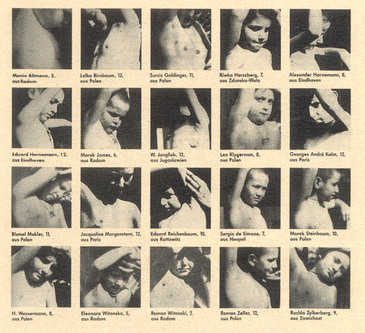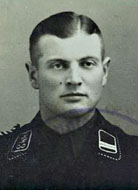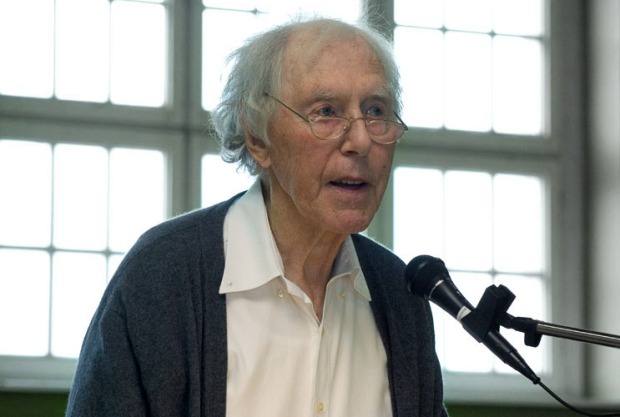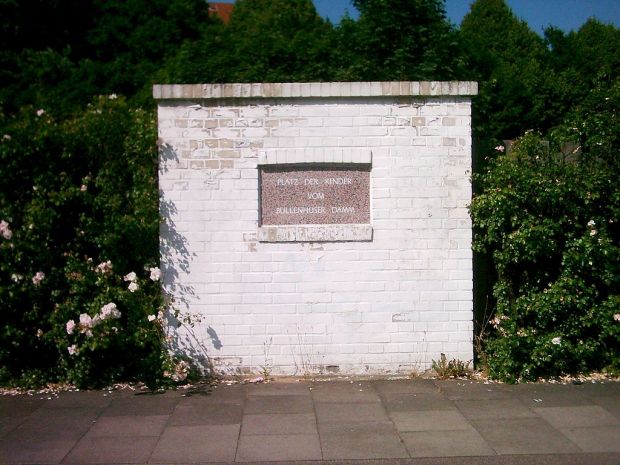
In November 1944 20 Jewish children, ten boys and ten girls, had been brought from Auschwitz to the concentration camp of Neuengamme, just outside Hamburg.
Below are pictures of 3 of the children-Jacqueline Morgenstern,Georges Andre Kohn and Sergio de Desimone.
The youngsters, aged between 5 and 12 years old, came from all over Europe and were to be human guinea-pigs in a series of medical experiments conducted by the SS doctor Kurt Heissmeyer.

Dr. Heissmeyer removed the children’s lymph glands for analysis, and he injected living tuberculosis bacteria in their veins and directly into their lungs to determine if they had any natural immunities to tuberculosis. They were carefully observed, examined and photographed as the disease progressed. The condition of all the children deteriorated very rapidly and they became extremely ill.
On April 20, 1945, the day on which Adolf Hitler was celebrating his fifty-sixth birthday and just a few days before the war ended, Heissmeyer and SS-Obersturmführer Arnold Strippel decided to kill the children in an effort to hide evidence of the experiments from the approaching Allied forces. To conceal all traces the SS transported the children to the former Bullenhuser Damm School, which had been used as a satellite camp since October 1944. They were immediately taken to the basement and ordered to undress. An SS officer later reported: “They sat down on the benches all around and were cheerful and happy that they had been for once allowed out of Neuengamme. The children were completely unsuspecting.”
The children were told that they had to be vaccinated against typhoid fever before their return journey. Then they were injected with morphine. They were hanged from hooks on the wall, but the SS men found it difficult to kill the mutilated children. The first child to be strung up was so light – due to disease and malnutrition – that the rope wouldn’t strangle him. SS untersturmführer Frahm had to use all of his own weight to tighten the noose. Then he hanged the others, two at a time, from different hooks. ‘Just like pictures on the wall’, he would recall later. He added that none of the children had cried.

Four of the adult prisoners who had been looking after them in the camp were also killed on that day., The adults are the two French doctors, Gabriel Florence and René Quenouille, and the Dutchmen Dirk Deutekom(no picture available) and Anton Hölzel.
The SS physician Kurt Heissmeyer desired to obtain a professorship. In order to do so he needed to present original research. Although previously disproven, his hypothesis was that the injection of live tuberculosis bacilli into subjects would act as a vaccine. Another component of his experimentation was based on pseudoscientific Nazi racial theory that race played a factor in developing tuberculosis.
He attempted to prove his hypothesis by injecting live tuberculosis bacilli into the lungs and bloodstream of “Untermenschen” (subhumans), Jews and Slavs being considered by the Nazis to be racially inferior to Germans.
He was able to have the facilities made available and to test his subjects as a result of his personal connections: his uncle, SS general August Heissmeyer, and his close acquaintance, SS general Oswald Pohl.
The medical experiments on tuberculosis infection were initially carried out on prisoners from the Soviet Union and other countries at the Neuengamme concentration camp. The experiments were then extended to Jews. For this Heissmeyer chose to use Jewish children. Twenty Jewish children (10 boys and 10 girls) from Auschwitz concentration camp were chosen by Josef Mengele and sent to Neuengamme. Mengele allegedly asked the children, “Who wants to go and see their mother?
The children were accompanied to Neuengamme by four women prisoners. Two were Polish nurses and one was a Hungarian pharmacist, and they were killed upon arrival at Neuengamme. The fourth woman, Polish-born Jew Paula Trocki, was a doctor. She survived the war and later gave testimony in Jerusalem about what she had witnessed:
“The transport was accompanied by an SS guard. There were 20 children, one female medical doctor, three nurses. The transport was in a separate carriage that was coupled on a normal train. Presented in this manner it appeared to be an ordinary carriage. We had to take off the stars of David lest we attract any attention. To prevent people from approaching us they said it was a transport of people suffering from typhoid fever… The food was excellent; on that journey we were given chocolate and milk. After a two-day trip we arrived at Neuengamme at ten o’clock at night”
The children were injected with live tuberculosis bacilli, and they all became ill.

Heissmeyer then had their axillary lymph nodes surgically removed from their armpits and sent to Dr Hans Klein at the Hohenlychen Hospital for study. All the children were photographed holding up one arm to show the surgical incision. Dr Klein was not prosecuted.
The children were injected with live tuberculosis bacilli, and they all became ill. Heissmeyer then had their axillary lymph nodes surgically removed from their armpits and sent to Dr Hans Klein at the Hohenlychen Hospital for study. All the children were photographed holding up one arm to show the surgical incision. Dr Klein was not prosecuted.
The collapsing western front and imminent approach of British troops prompted the perpetrators to murder the subjects of the experiment to cover up their crimes. The orders for the murders were issued from Berlin.
The children, their four adult caretakers and six Soviet prisoners were brought by truck to the Bullenhuser Damm School in the Hamburg suburb of Rothenburgsort. The school had been taken over by the SS to house prisoners from Neuengamme used to clear rubble from the surrounding area after Allied bombing raids. The SS evacuated the building around April 11, 1945 leaving a skeleton crew of two SS guards: Ewald Jauch and Johann Frahm and a janitor. They were accompanied by three SS guards (Wilhelm Dreimann, Adolf Speck, and Heinrich Wiehagen,no picture), as well as the driver, Hans Friedrich Petersen(no picture), and SS physician Alfred Trzebinski. The children as well as others were told they were being taken to Theresienstadt. Upon arriving at the school they were led into the basement.
They were then made to undress and were then injected with morphine by Trzebinski. They were then led into an adjacent room and hanged from hooks set into the wall. The execution was overseen by SS Obersturmführer Arnold Strippel.

The first child to be hanged was so light that the noose would not tighten. Frahm grabbed him in a bearhug and used his own weight to pull down and tighten the noose. The adults were hanged from overhead pipes; they were made to stand on a box, which was pulled away from under them. That same night, about 30 additional Soviet prisoners were also brought by lorry to the school to be executed; six escaped, three were shot trying to do so, and the rest were hanged in the basement.
Some of those involved in the killings were tried by the British in the Curio Haus in Hamburg in 1946. Trzebinski, Neuengamme commandant Max Pauly, Dreimann, Speck, Jauch and Frahm were convicted and given the death sentence. They were hanged on October 8, 1946.
Two of those directly responsible for the children’s suffering and murder, Kurt Heissmeyer and Arnold Strippel, escaped initially but were caught later. Strippel had served at other concentration camps before Neuengamme, including Buchenwald. He was recognized on the street in Frankfurt in 1948 by a former Buchenwald prisoner. He was tried for the murders of 21 Jewish inmates committed on November 9, 1939 as retribution for the failed assassination of Adolf Hitler at the Bürgerbräukeller in Munich by Georg Elser. Strippel was tried, convicted and sentenced to 21 life terms by a Frankfurt court in 1949
In 1964, an investigation into his involvement with the Bullenhuser Damm School murders was begun by the Hamburg prosecutor’s office. The statute of limitations had run out for manslaughter so he had to be charged with murder. Among the criteria for murder it had to be proven that the accused acted cruelly, insidiously or with motive. In 1967 the prosecutor, Helmut Münzberg, dropped the charges for lack of evidence, stating that Strippel had not acted cruelly as “the children had not been harmed beyond the extinction of their lives”.
He was released from prison in 1969. After his release, he applied for a retrial, and in 1970 his original conviction was overturned and he was retried. At this retrial, he was convicted as being just an accessory to the Buchenwald murders and sentenced to six years’ imprisonment. Because he had already served 20 years in prison, 14 years longer than this sentence, he was compensated with 121,477.92 Deutschmarks.
In 1979, partly as a result of articles written by Günther Schwarberg, Strippel’s case was reopened.

He was not re-incarcerated, and in 1987 the case was abandoned by the Hamburg prosecutor’s office, owing to Strippel’s frailty. Strippel died on May 1, 1994.
Kurt Heissmeyer returned to his home in Magdeburg in postwar East Germany and started a successful medical practice as a lung and tuberculosis specialist. He was eventually found out in 1959. In 1966, he was convicted and sentenced to life imprisonment. At his trial he stated, “I did not think that inmates of a camp had full value as human beings.” When asked why he did not use guinea pigs he responded, “For me there was no basic difference between human beings and guinea pigs.” He then corrected himself: “Jews and guinea pigs”.Heissmeyer died on August 29, 1967
The building at Bullenhuser Damm was used by the British as a transit camp for German POWs until 1947. It was then used by the Hydrograpichal Institute’s meteorological service until 1949, when it again became a school, for 800 boys. In 1959, the organization representing Neuengamme survivors proposed to the Hamburg school board that a memorial plaque should be placed in the school. However, it was not until 1963 that the text for the plaque was approved.

The text aroused controversy because it omitted mention of the Soviet victims and did not state that the children were Jewish or give any information about their personal identity. In 1980, information signs were placed in the basement of the school, and the Senate of Hamburg (government) declared the school to be a memorial site, renaming it Janusz Korczak School: Korczak was a Polish—Jewish pediatrician and author who died at Treblinka extermination camp with about 190 orphans. A rose garden was established in 1985.
Later, in the Schnelsen Quarter of the city several streets were named after the children who died at the school and a memorial tablet was installed. Much of the work of identifying the victims and of bringing the story to the public’s attention was due to the efforts of Günther Schwarberg.
In 2005, Wolfgang Peiner, Minister of Finance of Hamburg, published plans to sell the building. However, after several protests a spokesman denied these plans.
In 2011 a new exhibition (telling the story in German and English) was opened at the Memorial.

Not one of the children of Bullenhuser Damm was older than twelve. Stripped of their childhoods, they lived and died during the dark years of the Holocaust and were victims of the Nazi regime. Had they survived another two weeks, they would have been liberated by the Allied forces.
Alexander Hornemann, 8, the Netherlands
Eduard Hornemann, 12, the Netherlands
Marek Steinbaum, 10, Poland
Marek James, 6, Poland
W. Junglieb, 12, Yugoslavia
Roman Witonski, 7, Poland
Roman Zeller, 12, Poland
Sergio de Simone, 7, Italy
Georges Andre Kohn, 12, France
Eduard Reichenbaum, 10, Poland
Jacqueline Morgenstern, 12, France
Surcis Goldinger, 11, Poland
Lelka Birnbaum, 12, Poland
Eleonora Witonska, 5, Poland
Ruchla Zylberberg, 10, Poland
H.Wasserman, 8, Poland
Lea Klygerman, 8, Poland
Rywka Herszberg, 7, Poland
Blumel Mekler, 11, Poland
Mania Altman, 5, Poland













I just want to let you know that I painted the portrait of Jacqueline morgenstern, in order to transmit her memory and through this portrait the memory of all the children of Bullenhuser damm. You can see it on this link :

I present this portrait with a lot of others in my exhibition “témoigner de ces vies” (witnessing these lives). It is an exhibition that create a European path of remembrance from a place to another (60 exhibitions since 2008). The next one will be in Duisbourg for the 300th birthday of teh harbourg of Duisbourg. The portrait of Jacqueline Morgenstern will be exhibited there from 18 september until 3 Oktober. The oppening will be Sunday the 18 september. You can see other portraits on my three langages website:www.fmayran.com
All the best
Francine mayran
LikeLiked by 1 person
Thanks for sharing
LikeLike
As always, Thank you, Francine, for sharing your beautiful portrait of our dear cousin, Jacqueline Morgenstern. Your work should forever continue to tell the True story of ALL the 20 innocent Jewish children whose lives were so viciously stolen. May their memory be forever a blessing…. and may your work forever contribute to teaching the world the Truth.
LikeLiked by 1 person
Thank you, dirkdeklein, for sharing this terrible story of the 20 innocent Jewish children whose lives were viciously stolen. And thank you, Francine for sharing your beautiful portrait of our dear cousin, Jacqueline Morgenstern. May their memory be a blessing… and may their story touch the lives of the world to forever know the truth.
LikeLike
Thank you for telling the story of Bullenhuser Damm and of my ancestors, Roman and Eleonora Witonski. It turns out that in the past, I had seen the medical pictures of the children & not realized that I was looking at my own family. Thank you so much for this account, peace & blessings to you.
LikeLike
You are more than welcome
LikeLike
Reblogged this on History of Sorts.
LikeLike